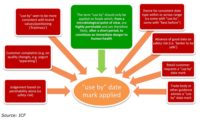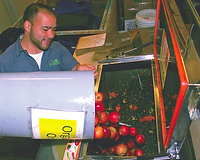In the wake of the Great Depression and World War II, Americans were mindful of their food purchases to ensure there was enough food for soldiers. However, today the average American family throws away almost $1,500 per year in wasted food.
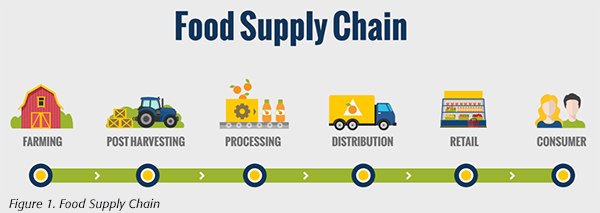 One of the biggest areas of food waste is maintaining the cold chain. It’s estimated that almost 20 percent of global food loss is caused by an incomplete cold chain. This means that all players in food supply—including producers, shippers, warehouses, retailers and consumers (Figure 1)—have a role to fill when it comes to tackling the challenge of food waste.
One of the biggest areas of food waste is maintaining the cold chain. It’s estimated that almost 20 percent of global food loss is caused by an incomplete cold chain. This means that all players in food supply—including producers, shippers, warehouses, retailers and consumers (Figure 1)—have a role to fill when it comes to tackling the challenge of food waste.
One measure refrigerated food producers can take is to extend the shelf life of their perishable products. This helps maintain the highest quality product over a longer period and reduces the likelihood of the product being discarded too early because of uncertainty of spoilage. Shelf life extension not only has potential to thwart food spoilage, but it also reduces the amount of edible food that ends up in the trash.
Long Live Shelf Life
 The refrigerated food industry is seeing staggering amounts of food loss and waste at every step of the cold chain supply (Figure 2). The retail stage is especially waste-prone. Approximately 80 percent of food loss takes place at or after the retail level in the United States. Most of this trashed food is comprised of refrigerated items such as produce, meat, seafood, beverages and ready-made foods.
The refrigerated food industry is seeing staggering amounts of food loss and waste at every step of the cold chain supply (Figure 2). The retail stage is especially waste-prone. Approximately 80 percent of food loss takes place at or after the retail level in the United States. Most of this trashed food is comprised of refrigerated items such as produce, meat, seafood, beverages and ready-made foods.
However, retailers aren’t solely responsible for reducing food waste at their stores. Consider the following example of two apple juice manufacturers.
Manufacturer A harvests 10,000 pounds of apples per day, producing roughly 5,000 pounds of juice. This company does not use a modern preservation method, so its juice has a shelf life of up to five days. Assuming a 10 percent loss, over 30 days, Manufacturer A loses 15,000 pounds of apple juice.
On the other hand, Manufacturer B harvests the same number of apples, but its manufacturing process includes utilizing high-pressure processing (HPP), giving it a shelf life of up to 50 days. Assuming a one percent loss, Manufacturer B only loses 1,500 pounds of juice after 30 days.
By extending the shelf life of its apple juice, Manufacturer B can reduce spoilage by 90 percent, sell more juice and build trust with its customers by contributing to the fight against food waste, providing a consistent product and safe food with clean labels that avoid preservatives. Assuming the juice cost $5 per gallon, that’s more than $8,000 per month that Manufacturer A and their retail customers miss out on.
Reducing spoilage goes beyond a simple economic reduction of costs—it can also help build customer awareness and loyalty. Today’s conscientious businesses are embracing a triple bottom line mentality of people, planet and profit—and reducing food waste is a strong step in the right direction.
Put Spoilage Organisms under Pressure
One promising step companies can take to extend their product shelf life is HPP, referenced above, an increasingly popular processing method that not only significantly extends use by dates, but also retains taste and nutritional content of foods and beverages.
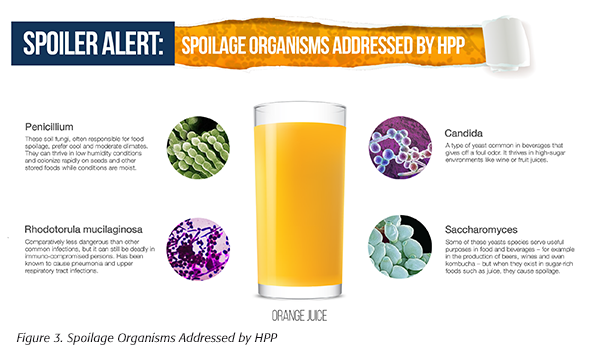 HPP is a food processing technique that uses cold water pressure, instead of heat, to inactivate spoilage organisms (Figure 3). The technology has broad application across a variety of refrigerated products such as meats, fresh juices and smoothies, deli salads, dips, ready-to-eat meals, fruits and veggies, and pet food.
HPP is a food processing technique that uses cold water pressure, instead of heat, to inactivate spoilage organisms (Figure 3). The technology has broad application across a variety of refrigerated products such as meats, fresh juices and smoothies, deli salads, dips, ready-to-eat meals, fruits and veggies, and pet food.
HPP is beneficial for many reasons, including food safety, nutrient preservation and clean-label enablement. In addition, one of the most notable benefits of HPP is its ability to extend the shelf life of products by more than double in most cases and up to 10 times more shelf life.
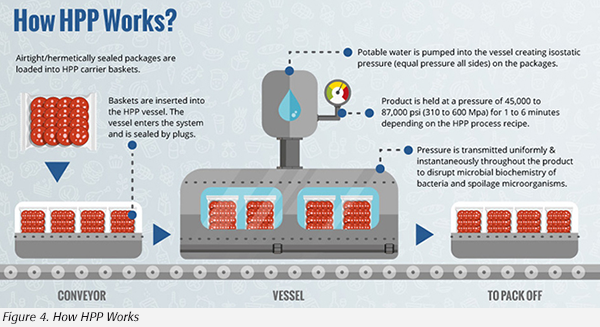 The technology works by distributing pressure equally on foods or beverages to disrupt the microbial biochemistry of bacteria and spoilage organisms (Figure 4). It is recognized by the U.S. Department of Agriculture and the U.S. Food and Drug Administration as a lethality step, allowing many food producers to incorporate it into their Hazard Analysis and Critical Control Points plan.
The technology works by distributing pressure equally on foods or beverages to disrupt the microbial biochemistry of bacteria and spoilage organisms (Figure 4). It is recognized by the U.S. Department of Agriculture and the U.S. Food and Drug Administration as a lethality step, allowing many food producers to incorporate it into their Hazard Analysis and Critical Control Points plan.
The process includes loading products into a large HPP vessel while in their final, sealed packaging. Then potable water is pumped into the vessel, creating equal pressure on all sides of the foods. Depending on the food, packages are held at pressures between 45,000–87,000 psi for one to six minutes until pathogens and fungi are inactivated.
For companies that desire the benefits of HPP and can’t make the capital investment, third-party HPP service providers provide HPP capabilities and other pre- and post-HPP value-added services that give any size company access to the modern technology.
In addition to HPP, researchers are exploring several scientific advancements that help extend refrigerated product shelf life.
Trap Gas to Slow Ripening
Spoiled produce comprises one-third of all food waste. Once fruits are harvested, they start emitting ethylene gas, a naturally occurring gas that acts as a ripening hormone for fruits and vegetables. The more time produce is on the shelf, the quicker it creates ethylene, speeding up spoilage characteristics such as softening, growing mold and abscission.
Researchers have found ways to stymie ethylene’s progression to slow spoilage in fruits and vegetables. One method is called modified atmosphere packaging (MAP), in which produce respires in a package that allows some carbon dioxide to escape and some oxygen to enter.
Food producers have seen success when combining MAP with ethylene adsorption sheets that capture the gas and slow down the ripening process. The sheets are inserted into fruit and vegetable containers to trap nearby ethylene molecules and extend shelf life of produce.
MAP packages are also commonly used by meat manufacturers for aesthetic purposes, but this creates a higher price point for the consumer so a longer shelf life is even more desirable. Many meat manufacturers use HPP to further extend the shelf life of the MAP packaged products to ensure that shrink on these premium products is minimal.
Use Modern Packaging Films to Assist in Optimizing Product Shelf Life
Another method of preserving food is reducing its exposure to oxygen by using modern clear plastic wrap. Consumers have used traditional clear plastic wrap to store leftovers since the 1950s. These guards work by preventing all kinds of perishable food—from meats to deli salads—from being exposed to oxygen, thus slowing down spoilage.
While common plastic wrap is effective in preserving food to some extent, today’s researchers have gone a step further by infusing plastic films with antimicrobial extracts that help extend shelf life and improve food safety. Scientists have discovered natural extracts, such as grapefruit, rosemary and crustacean shells, that kill pathogenic microorganisms without the use of chemicals. Additionally, the combination of antimicrobials and HPP have a synergistic relationship which can even further extend shelf life, in particular for challenging products that may have very little to no sodium, alkaline food matrix or greater exposure to microorganisms.
By minimizing spoilage bacteria, products experience an extended shelf life, just like the above example of apple juice manufacturers. With a holistic view of food production and how it relates to people, the planet and profits, companies can take actionable steps to keep products on shelves longer and ultimately reduce food waste.
The author thanks Universal Pure for supplying the images for the article.
Joyce Longfield is a food safety and high pressure processing consultant.
Resources
1. news.nationalgeographic.com/news/2014/10/141013-food-waste-national-security-environment-science-ngfood/
2. www.iifiir.org/userfiles/file/publications/notes/NoteTech_29_EN.pdf.
3. www.unep.org/ourplanet/september-2015/unep-publications/global-waste-management-outlook.
4. www.ers.usda.gov/topics/food-nutrition-assistance/food-security-in-the-us/key-statistics-graphics.aspx#foodsecure.
5. www.ncbi.nlm.nih.gov/pmc/articles/PMC4468856/.


